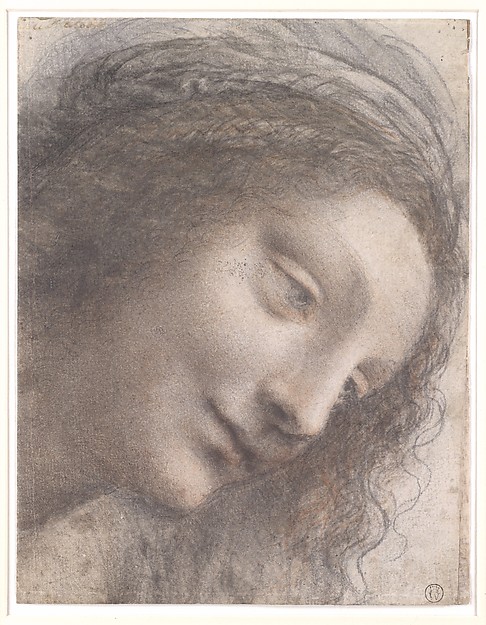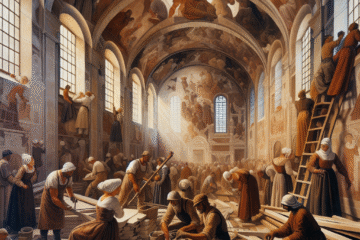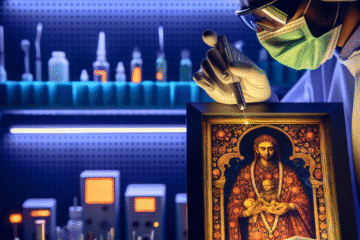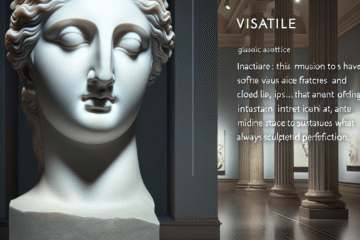
Image title: The Head of the Virgin in Three-Quarter View Facing Right
Medium: Black chalk, charcoal, and red chalk, with some traces of white chalk (?); some remains of framing lines in pen and brown ink at upper right (not by Leonardo)
Date: 1510–13
Source:
The Met Collection
“
Every artist dips his brush in his own soul, and paints his own nature into his pictures.
”
— Henry Ward Beecher
‘Drawing is Thinking’: How Leonardo da Vinci Sketched His Mind into Being
Introduction: The Mind’s Eye in Motion
Leonardo da Vinci was not just a painter, inventor, or anatomist. He was a visual philosopher who used drawing as a tool to interrogate existence. In a unique convergence of art and science, Leonardo’s sketches act not as aesthetic endpoints but rather as beginnings—critical nodes in an expanding network of inquiry. To observe his notebooks is to witness a mind in active synthesis, turning inward thoughts into outward lines. This blog will explore how da Vinci’s drawings functioned as cognitive maps—visual manifestations of thought, curiosity, and invention that blurred the boundaries between scientific exploration and artistic expression.
1. The Sketchbook as Laboratory
Long before the modern scientific method was formalized, Leonardo used drawing not merely to record observations but to hypothesize, compare, and experiment. His notebooks are littered with disjointed thoughts—spiraling water studies, dissected limbs, dreamlike flying machines—all sketched with a deliberate, questioning hand. Leonardo did not necessarily set out to create finished diagrams; rather, he was drawing in order to think. The meticulous renderings of human organs, swirling eddies, and architectural plans were part of a dynamic process—a lab of chalk, ink, and vellum where intuition met inquiry.
Drawing for Leonardo was a prosthesis for the mind, and his choice of medium—pencil, silverpoint, red chalk—became extensions of his thought process. Far from passive documentation, these marks were how he interrogated reality. He believed that to truly understand nature, one must draw it from life—physically participate in seeing. The act of mapping the muscles of a horse or the intricate valves of the heart was an immersive form of knowledge acquisition.
2. Anatomy: Dissecting the Invisible
Perhaps nowhere is Leonardo’s fusion of art and intellect more evident than in his anatomical studies. In the 1480s, he began dissecting human cadavers—first out of artistic necessity and then from insatiable scientific hunger. His drawing of the human fetus in the womb remains iconic not for its clarity alone but for its compassionate attention to both the mechanics and mystery of life.
Drawing allowed Leonardo to layer understanding. While early anatomical diagrams by others were often stylized or symbolic, his were investigative and grounded in empirical observation. He frequently included multiple views—cross-sections, detailed muscle flows, and comparative animal anatomy—to create what we might today call a 3D model on paper. His sketches are not only visually breathtaking; they are also epistemological statements, aiming to depict knowledge in its entirety.
3. Architecture, Flight, and the Geometry of Thought
Leonardo’s fascination with proportion and spatial harmony extended beyond anatomy into the realms of architecture and engineering. His Vitruvian Man, based on the writings of the Roman architect Vitruvius, is more than a study of human proportion—it’s a declaration of the physical and metaphysical unity between man and cosmos, nature and design. The drawing harmonizes circle and square, flesh and form, and becomes a visual thesis of Renaissance humanism.
Elsewhere in his notebooks, one finds fantastical machines, early concepts of helicopters, parachutes, and siege engines—all coalescing through layers of restless sketching. Many were never built, but that was beside the point. The sketches were mental scaffolds—drawings as blueprints of possibility. Leonardo imagined the machine before it could exist, using the page as both stage and workshop for his speculative engineering.
4. Influence and Legacy: Drawing as Process
Leonardo’s notebooks did not circulate widely during his lifetime, which meant that their radical implications remained relatively obscure until centuries later. But once rediscovered, they catalyzed shifts in both art and science. Later inventors and thinkers—from Galileo to Buckminster Fuller—echoed his interdisciplinary vision. In modern art education, drawing as process rather than product finds its lineage in Leonardo. Courses in figure drawing, design thinking, and even bioengineering now emulate his approach: observe, sketch, question, repeat.
Importantly, Leonardo’s approach foreshadowed a broader epistemic shift. In the Enlightenment and later in Modernism, drawing increasingly emerged not just as representation but as iteration and cognition. Today, in design thinking and digital prototyping, the idea of sketching to explore rather than depict directly traces back to the studio-laboratory that was Leonardo’s mind.
5. Drawing For a Digital Age
In our contemporary moment, where artificial intelligence and digital tools dominate the creative process, Leonardo’s sketchbooks remind us of the power of the analog mind. His blend of empirical observation with intuitive exploration offers enduring lessons on creativity, interdisciplinarity, and the virtues of curiosity. The Renaissance polymath did not merely represent the world—he reimagined it, line by live line.
New technologies like generative design algorithms and neural imaging align with Leonardo’s impulse to merge art and science. Imagine if he had access to CAD software or 3D modeling—yet one suspects he would still begin with a rough charcoal sketch. Drawing was his way of thinking, of interrogating the world’s edges and stitching them into coherent wholes. In the age of high-speed-thinking machines, da Vinci’s slow, deliberate line reminds us of the enduring intelligence of the sketchbook.
Conclusion: Endless Inquiry in Graphite and Ink
Leonardo da Vinci’s drawings are not fossilized thoughts but living inquiries—flickers of what it means to wonder. They escape categorization; they are maps, machines, dreams, dissections, speculations. For Leonardo, drawing was not a step on the way to painting—it was the way to understand. “Drawing is thinking,” he might have said with his stylus in hand and the future in view. And in that simple truth lies a revolution still unfolding.

Image description:
Sketch of a woman, Rosa Caroline Praed notebooks, 1880s. A collection of the personal papers and manuscripts of Rosa Caroline Praed, comprising correspondence, press cuttings, royalty statements, notebooks, diaries, and legal documents. The collection also includes the manuscript for the book “Soul of Nyria”.
License:
CC BY 4.0
Source:
Wikimedia Commons
Useful links:


